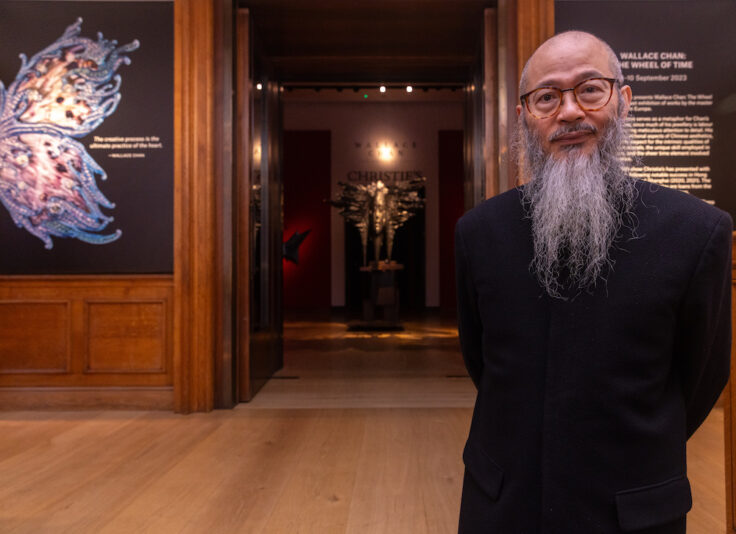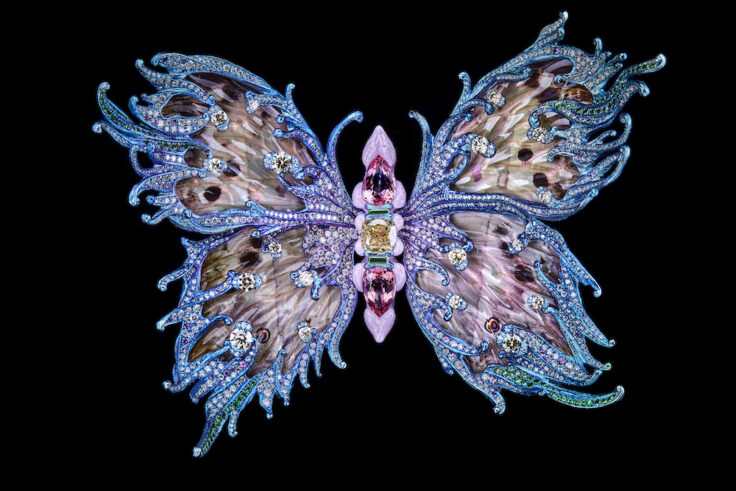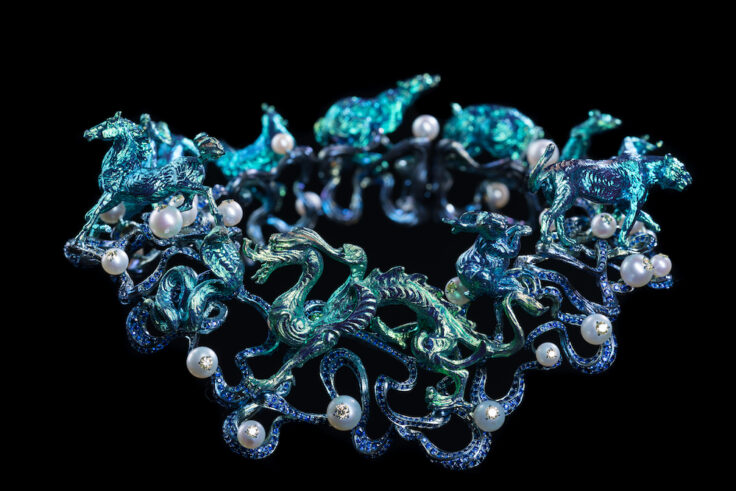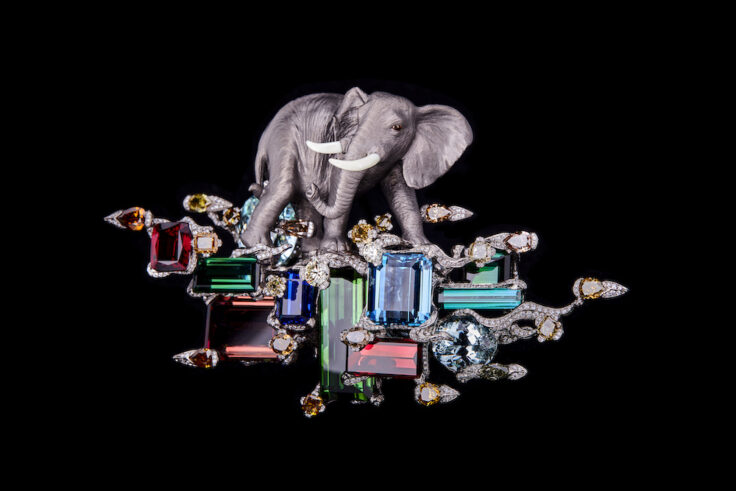How does one even begin to write about the level of skill, mastery, patience, and meticulous attention-to-detail that goes into a Wallace Chan creation? The Hong Kong-based jewelry designer and sculptor, whose work was presented at Christies London in an exhibition titled The Wheel of Time last week, is globally recognized for single-handedly redefining the world of contemporary jewelry over his decades-spanning career, carving out breathtaking pieces that would stop anyone in their tracks. Known as a “living national treasure” in China, the artist injects each of his dazzling creations with emotions and meaning— there’s a profound story behind all of the pieces he sets out to make— hoping that his work outlasts him, stands the test of time, and can be passed down from generation to generation. Using precious stones like lapis, emeralds, jadeite, and ever-lasting materials such as titanium (because it doesn’t rust), Chan’s unique and limited-edition brooches, necklaces, and earrings are pure sculpture.
I got the chance to witness his artistry first-hand during Christie’s week-long exhibition, which was the largest retrospective of works by the master jeweler in Europe (Chan’s work has been exhibited previously at Christie’s in Hong Kong and Shanghai.) Since it was founded by James Christie in London in 1766, the world-renowned auction house has persistently championed one-of-a-kind artists, including in July, when more than 100 works of Middle East art, including paintings, sculptures, drawings and installations from between 1939 and 2023, went on display in London as part of Christie’s summer exhibition.
The Wheel of Time— a metaphor for Chan’s labour-intensive working process— which ran from Sep. 4 to 10 featured over 150-pieces of some of Chan’s most iconic creations as well as 20 never-before-seen works and series of titanium and iron sculptures, offering an in-depth exploration into the inner-workings of the artist’s brilliant mind. A majority of the pieces on display were generously on loan from many of Chan’s major international collectors. Standouts included Stilled Life, an imperial jadeite brooch and sculpture that masterfully depicts a cicada resting on a bamboo leaf carved with “cicada patterns” found on ancient Chinese bronze vessels dating as far back as the Shang dynasty; Metamorphosis, a delicate butterfly in motion made out of diamond, ruby, emerald, sapphire, and crystals; and Legend of the Color Black, which is a remarkable black diamond shoulder brooch sculpture boasting one of the largest known cut black diamonds in the world (312.24 carats) alongside silver grey diamonds, crystal sapphire, black agate, titanium, and the Wallace Chan Porcelain, a material Chan has spent years developing which is five times stronger than steel.
Chan first introduced the porcelain in 2018. The material was a response to a childhood incident that would go on to deeply impact the way he perceives the world and his work. The artist grew up in extreme poverty in Hong Kong, and he and his siblings were so poor they were forced to share a plastic spoon to eat. Meanwhile, the adults also shared a spoon, but it was made of porcelain. As a curious five-year-old, Chan handled the spoon and it accidentally slipped from his hands and shattered into tiny pieces on the floor, which resulted in severe punishment from his grandmother.
Porcelain is very dense. It is nearly twice the density of sapphire, so it is highly difficult to polish. The end result, however, is a material with an extremely high lustre that will not dull over time. Chan’s desire to constantly innovate in terms of techniques, materials, and tools, has also resulted in a plethora of other inventions, including the “Wallace Cut” (and the tools to carry it out), which is a patented method of carving designs within a gemstone. Founded in 1987, the technique uses cameos and intaglios to create a lifelike image that is then reflected within the stone to create a three-dimensional effect. The award-winning illusionary technique took two-and-a-half years to perfect. The painstaking carving process had to be completed in water to prevent heat and tension, which would damage the stone, and subsequently confirmed Chan’s status as a master sculptor.
In addition to the Wallace Cut, Chan has developed new methods of cutting and setting to minimize the visibility of metal between precious stones. He has also pioneered a technology to enhance the luminosity of jadeite.
Chan came to jewelry designing via an apprenticeship at a gemstone-carving factory at the age of 16 through his uncle. Growing bored of the repetitive and mundane nature of the work, Chan quit his job and begged his furious parents to lend him about $130 so he could purchase his own carving machine. He would use the profits made from his traditional Chinese figure carvings to buy more gemstones so that he could produce more pieces to sell.
In the early 2000s, he decided to live as a monk for six months, giving up all of his worldly possessions. He soon realized that art and being creative was the only way for him to achieve higher wisdom. “For me, the most difficult part is not being able to create on a daily basis,” he once said. “If I don’t create, I find it difficult.” He then set out using discarded materials (as he got rid of all of his possessions) to create. One of his first sculptures following monkery was carved out of a block of concrete. From there, Chan went on to produce jewelry from broken vases, teapots, and discarded bottles. He even immortalized a dead butterfly into a brooch, a three-year-long process that saw the artist set the dead butterfly’s wings in between crystal and mother-of-pearl, using titanium as the structure.
Sustainability is at the heart of the work, whether it’s through using discarded items or materials that will last for eternity, and so is the spirit of Chinese culture. He was the first Chinese jewelry designer to exhibit at TEFAF New York in 2016 and at the Biennale des Antiquaires in Paris, the world’s premiere haute jewelry exhibition, in 2012. In 2019, his jewelry creation, A New Generation, was added to the permanent collection of the British Museum, and it is the first Chinese contemporary jewelry art piece to be included in the museum’s permanent collection. He is also known for designing the world’s most expensive necklace.
Worth $200 million, A Heritage in Bloom is comprised of 383.4 carats in precious stones accented by a colorless diamond. The project started in 2010 when Chow Tai Fook, a Hong Kong jewelry company, acquired an extremely rare, unpolished 507-carat diamond found in the Cullinan mine in South Africa. It commissioned Mr. Chan to craft the stone into a masterpiece that would become part of China’s long history of jewelry design. The final product took 47,000 hours of work to complete.








